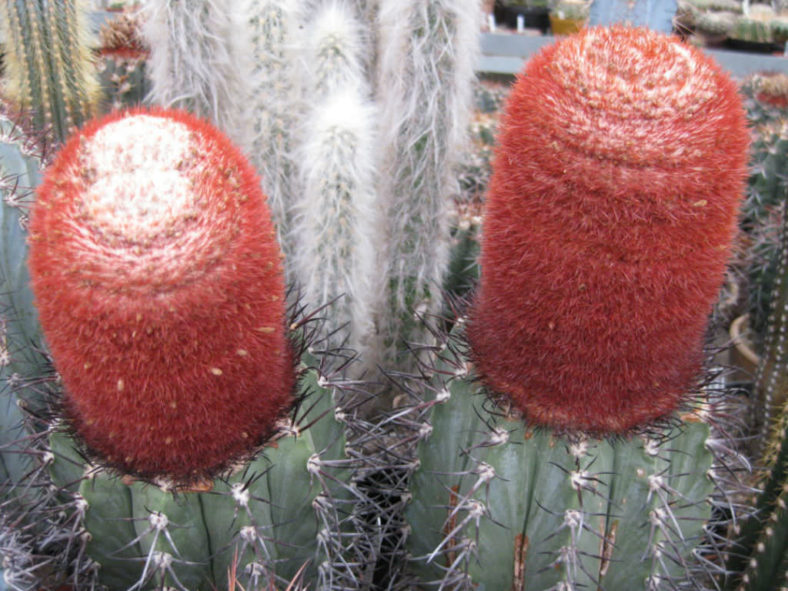Melocactus is a genus of especially aesthetically attractive cacti distinguishable by their odd cephalium that protrudes from the top. The cephalium (plural: cephalia), a bristly collection of areoles, is designed to produce flowers and fruit and grow up to 3 feet (90 cm) tall in some species. Cephalia are red or white and form small pink flowers inside their mass, and their fruits are waxy and shaped like tubes.
Because of their appearance, the members of Melocactus are popular cacti in cultivation. They are native to places with high temperatures and cannot tolerate frost. Melocactus are found in various parts of the Caribbean, South America (especially Brazil), and Mexico. Notably, Melocactus only develop their distinctive look once they reach maturity.
At the beginning of their lives, their appearance is typical of most cacti. They are spherical and ribbed all over with areoles. Plants develop the cephalium once they are fully developed, and once it begins growing, it will not stop until the plant itself dies. So they can be hard to identify before they have reached maturity. Melocactus can be a bit of a challenge due to some specificities in their care requirements. These cacti are a better choice for experienced cactus growers. They are quite beautiful and extraordinary once fully grown.
Growing Conditions
Light: Lots of bright sunlight is necessary for Melocactus to thrive.
Water: These cacti like fairly moist environments, so water regularly, especially during the growing season. However, ensure not to let them sit in water to avoid rotting the roots.
Temperature: Warm tropical temperatures above 70 °F (21 °C). They cannot survive frost.
Soil: Most cactus potting mixes should work fine, ideally a well-draining mix with some organic material.
Fertilizer: Feed with a balanced, diluted fertilizer like a 20-20-20 mixed into their water during the growing season to help them develop.

Propagation
These cacti are not difficult to propagate from seed. First, sow the seeds in well-aerated soil that drains well, and make sure to soak them in warm water before you do. Then seal the new seeds to keep them in heat and moisture, which will help them root. Their root systems will take a little while to develop, so do not overwater or overfeed them before having the necessary equipment. Remember, always use fresh seeds.
Repotting
Notably, Melocactus like to be fairly packed in, so keep them in a fairly small container that slightly constricts their roots. Repotting them at the beginning of the growing season is a good idea until they form cephalium and the body stops growing. They should be repotted like other cacti by lifting the root ball out all at once, cleaning it gently, and replacing it. Ensure not to replant in too large a container to avoid damaging the plant.
Grower's Tips
Melocactus are somewhat finicky cacti with unusual requirements. The soil should not be allowed to completely dry out, even in winter, and they can suffer from soil composition, drainage, water level, sun, and more difficult control factors. Therefore, these plants are best for growers who have already successfully cultivated cacti. Establish a balance with good aeration matched by ample water and good soil matched by good drainage, and these cacti should continue to grow. Their unusual tops make them among the more beautiful desert cacti.
Source: about.com
Links
- Back to genus Melocactus
- Succupedia: Browse succulents by Scientific Name, Common Name, Genus, Family, USDA Hardiness Zone, Origin, or cacti by Genus